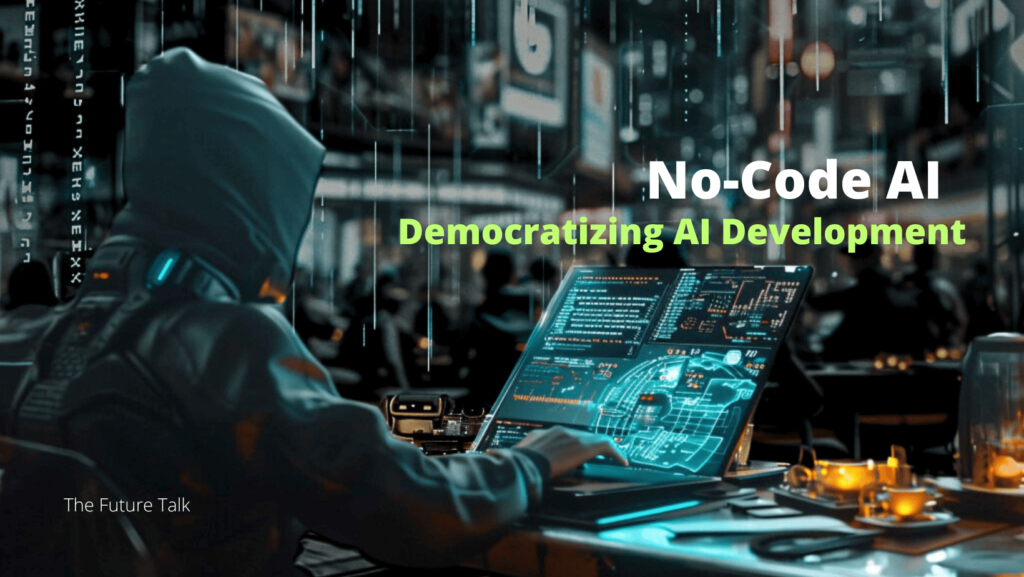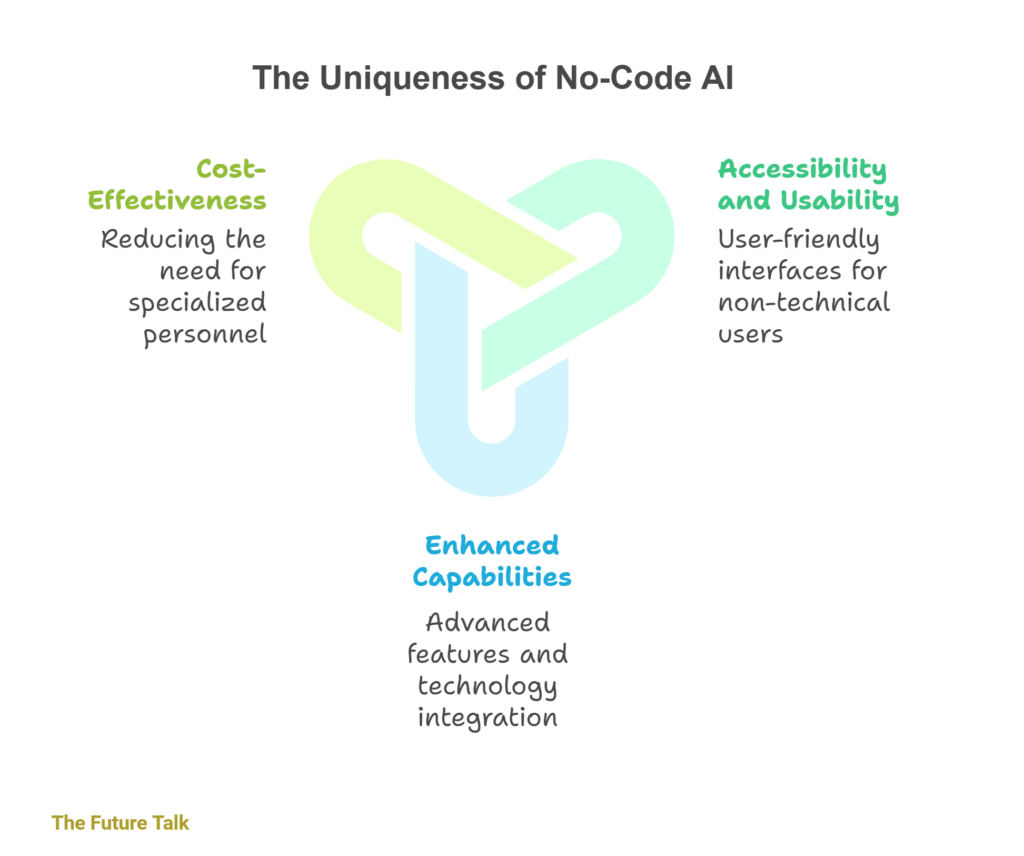No-code AI allows users with less or no technical background and coding knowledge to develop and deploy AI applications. Increased accessibility, enhanced capabilities, focus on Ethical AI, and training and support are the future of no-code AI.

What if I tell you that you can build your website, an application, or an AI model without coding or any programming language? Interesting, right? This is what No-Code AI does. Also known as codeless AI, no-code AI has brought about a revolution in AI-enabled application development without the need for coding expertise.
The global No-Code AI market is predicted to hit the US$ 31,155.5 million mark by 2031, from the estimated value of US$ 5,625.4 million by the end of 2024. The market is growing at a mammoth CAGR of 27.70% between 2024 and 2031, according to Kings Research.
What is No-Code AI?
By eliminating the necessity for coding, No-Code AI is defined as tools and platforms that enable users to build AI models and applications through intuitive interfaces. Think about Bubble, Appy Pie, Softr, or various other tools. They all are AI-powered website and app-making tools.
No-code AI allows users to create apps just by using drag-and-drop functionality. These tools are making AI accessible to non-developers such as marketers, business analysts, and entrepreneurs by abstracting the complexities of machine learning algorithms, data preprocessing, and deployment.
Also Read: 10 Cool Generative AI Tools Reshaping E-Commerce and Retail
What Makes No-Code AI Models Unique?

By making advanced technology accessible to non-coders and non-developers, No-code AI is democratizing artificial intelligence (AI). Let us have a detailed look at what makes no-code AI models unique:
Accessibility and Usability
No-code AI offers user-friendly interfaces, allowing users to develop, train, and deploy AI models through visual drag-and-drop tools. This democratizes AI and makes it accessible to non-technical users who can create AI solutions without writing a single line of code.
Enhanced Capabilities
With developments in no-code AI platforms, expectations of more sophisticated features like advanced machine learning techniques and enhanced integration with other technologies like IoT and blockchain are high. This will enable users to build more powerful and different AI applications.
Cost-Effectiveness
Traditionally, developing AI solutions requires skilled data scientists and software developers. This can be expensive. No-code AI tools eliminate the need for specialized personnel, thus reducing development costs.
Other key features which make no-code AI unique include:
- Pre-built Models and Templates
- Customization and Flexibility
- Collaborative Workflows
- Deployment and Monitoring
- Reduced Dependency on IT
- Increased Experimentation
The No-Code AI Impact – Industries and Use Cases
Every organization across different industries looks for digital transformation to drive business innovation. There are various sectors embracing no-code AI tools to enhance their business processes and operations. Some of the key industries leveraging no-code AI in their business functions are as follows:
| Industry | Use Cases |
| Healthcare | Medical imaging and diagnostics Predictive analytics and Administrative automation |
| Finance | Fraud detection, Credit scoring, Robo-advisors |
| Marketing | Customer segmentation, Campaign optimization, Content creation |
| Manufacturing | Predictive maintenance, Quality Control, Supply chain optimization |
| Retail | Inventory management, Chatbots and customer service, Customer personalization |
No-Code Development Vs Low-Code Development
The advent of no-code and low-code platforms has significantly revolutionized the software development landscape. Both platforms are designed to simplify and expedite application development, making it accessible to a wider audience, including those with less or no programming knowledge.
The table below depicts the differences between no-code and low-code development:
| No-Code Development | Low-Code Development |
| Allows users to develop applications without writing any code. | Provides a more flexible approach, enabling users to develop applications with minimal hand-coding. |
| Features: Visual Interface, Pre-built Templates, Drag-and-Drop Components | Features: Visual Development, Custom Coding, Reusable Components |
| Designed for business users, entrepreneurs, and non-technical individuals. | Designed for both developers and business users with some technical knowledge |
| Faster for simple applications thanks to the complete visual approach | Fast but may require additional time for custom coding and complex features |
Also Read: How AI is Introducing The Next-Generation Workplace
Popular No-Code AI Tools
No-code AI tools allow anyone to develop an entirely new business. Here are some popular no-code AI tools:
- Google AutoML – Helps developers build custom learning models in minutes.
- Amazon SageMaker – For developers to build, train, and deploy machine learning models at scale.
- Zapier – For workflow automation, app integration, and lead management.
- Clarifai – enables users to build AI-powered apps effortlessly.
- Webflow – For website design and development, e-commerce sites, landing pages, and blogs.
- Glide – For customized app development, CRM, event management, and team collaboration.
- AppGyver – For web and mobile app development, MVPs, and business process automation.
Also Read: The Next Wave: Top Digital Transformation Trends Driving Industrial Evolution
The Future of No-Code AI
Thanks to user-friendly interfaces, pre-built models, and integration capabilities, no-code AI platforms have garnered a lot of traction. Enhanced AutoML capabilities, integration of diverse data sources, and AI-enabled automation and workflows are some key trends of no-code AI.
For SMEs (small and medium enterprises), no-code AI can be a substantial investment in technical resources. These tools can help them with customer service chatbots, operational efficiencies, and personalized marketing. For marketers, no-code AI can assess customer data, predict trends, and optimize campaigns.
No-code models also present certain challenges that must be addressed. These challenges include data quality, scalability, security, and skill gaps.
In a crux, the future of no-code AI is much more promising with significant advancements in advanced technologies like AI-powered automation and ethical governance. No-code AI tools will not only democratize AI but also foster a culture of creativity and innovation.
Stay Tuned to The Future Talk for more such insights on technology!